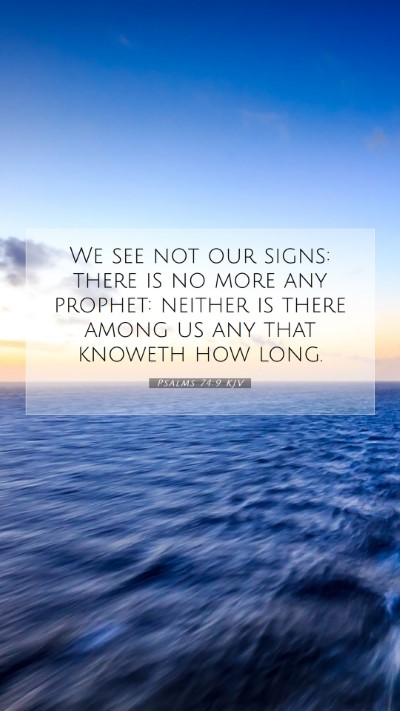Bible Verse Interpretation: Psalms 74:9
The verse Psalms 74:9 states, "We do not see our signs; there is no longer any prophet, and there is none among us who knows how long." This verse reflects a deep sense of desolation and the absence of divine guidance. In this summary, we will explore its meaning, backed by insights from public domain commentaries.
Summary of Insights
In Psalms 74:9, the psalmist expresses a profound spiritual crisis. The absence of prophetic signs indicates a disconnect between the people and God, suggesting a moment of desperation in their faith journey. Let’s break down the commentary insights:
-
Matthew Henry:
Henry emphasizes that this verse signifies a period of spiritual barrenness. The lack of "signs" represents a cessation of God’s visible guidance and miracles, leaving the people in spiritual darkness. The absence of prophets means that divine instruction is not available, highlighting the dire situation of the nation.
-
Albert Barnes:
Barnes points out that the people are mourning the lack of clear direction and understanding. Here, the "signs" refer to indications of God's presence and favor. The question "how long" reflects a longing for restoration, indicating their awareness of their need for God's intervention and guidance.
-
Adam Clarke:
Clarke notes that this verse can be seen as an appeal for help during a time of great distress. The lack of prophets might suggest that God has withdrawn His protective hand, leading to uncertainty about the future. The psalmist's cry for a sign reflects a desperation for God to reveal His will and bring comfort.
Understanding Psalms 74:9 in Context
The context of this verse revolves around Israel's historical experiences of defeat and captivity, particularly reflective of the Babylonian exile. It serves as a lament that highlights the relationship between God's presence and the well-being of His people.
Key Themes
-
Divine Absence:
The absence of prophetic voices can indicate a spiritual vacuum, leading to confusion and despair among the faithful.
-
Questions of Duration:
The cry “how long” evokes themes of patience and endurance in suffering, urging the community to remain hopeful amid trials.
-
Restoration and Hope:
The desire for signs and prophets is fundamentally a yearning for restoration, underlining the importance of divine communication.
Cross References
This verse connects with several other scripture passages that explore similar themes:
- Isaiah 29:10-12 - Reflecting on spiritual blindness and the seeking of understanding.
- Amos 8:11-12 - Prophecy about a famine of hearing God's words.
- Jeremiah 14:2-4 - Descriptive imagery of Judah in lament during times of trouble.
- Lamentations 2:9 - Addressing the absence of prophetic counsel.
- Ezekiel 7:26 - Discussing the silencing of prophets.
Application of Psalms 74:9 in Life
This verse encourages believers to recognize the necessity of staying connected to God’s guidance, especially during times of difficulty.
- Seek Spiritual Direction: Just as the psalmist lamented the absence of signs, modern believers are encouraged to seek God’s presence actively through prayer, scripture, and community.
- Endure with Hope: The question of “how long” can resonate with many in suffering, reminding us to remain hopeful and patient as we await divine response.
- Embrace Community Support: Engaging in Bible study groups and discussions can help believers interpret the signs of the times and support each other's faith journeys.
Conclusion
Psalms 74:9 serves as a poignant reminder of the longing for divine communication and guidance in challenging times. Through incorporating insights from Matthew Henry, Albert Barnes, and Adam Clarke, we find a rich tapestry of meaning that encourages reflection on our spiritual state and the importance of seeking God's presence. This verse not only invites interpretation but also fosters an understanding relevant to everyday life and our continuous walk of faith.
For those diving deeper into Bible study, examining the cross references and themes presented in Psalms 74:9 can yield significant insights and applications to contemporary challenges faced in our spiritual lives.


